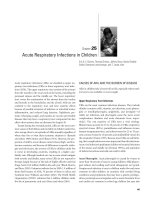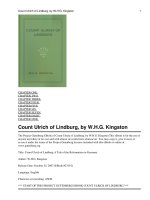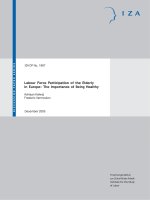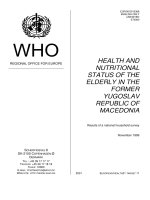HYDATID DISEASE OF THE LIVER IN CHILDREN ppt
Bạn đang xem bản rút gọn của tài liệu. Xem và tải ngay bản đầy đủ của tài liệu tại đây (48.06 KB, 18 trang )
1
HYDATID DISEASE OF THE LIVER IN CHILDREN
*A. Al-Bassam, FRCSEd, **H. Hassab, FRCSEd,**Y. Al-Olayet, MD, **Shadi, MD
**G. Al-Shami, MD, ***A. Al-Rabeeah, FRCS(C) and * A. Jawad, FRCSEd
*Department of Surgery, Division of Paediatric Surgery,
King Khalid University Hospital, Riyadh, Saudi Arabia
**Maternity & Children's Hospital, Riyadh, KSA
***King Faisal Specialist Hospital & Research Centre, Riyadh, KSA
PDF created with FinePrint pdfFactory trial version
2
HYDATID DISEASE OF THE LIVER IN CHILDREN
ABSTRACT:
Twenty one patients with hydatid disease of the liver were operated upon between
1986-1997. There were 10 males and 11 females. The mean age of the patients was 6.5
years (range 3 to 12 years). Abdominal distention with mass was the commonest method
of presentation symptoms (71.4%). This was followed by abdominal pain (38%).
Hepatomegaly with palpable mass was present in 57.1%. Three patients had concomitant
pulmonary and brain hydatid disease. The diagnosis was made using clinical, skin
testing, serology and imaging techniques. All patients received a preoperative course of
Mebendazole (50mg/kg/day) for a period ranging between 1-8 weeks. At surgery, 11
patients (52.3%) had a single cyst and 8 were located in the right lobe of liver. Ten
patients (47.6%) had multiple cysts occupying both lobes. Three forms of surgical
treatment were used: Capitonnage + partial excision of fibrous capsule; total excision of
the cyst; and external drainage of cyst cavity. We have to re-operate in 3 patients
(14.2%). The mean follow up of patients was 24 months. Although there were no deaths
in the series, 5 patients (23.8%) developed postoperative complications. Surgical
treatment in the form of primary closure of the cyst cavity without drainage, seems to
offer the best therapeutic option in these patients.
Key words: Liver cysts, hydatid disease, echinoccocosis.
PDF created with FinePrint pdfFactory trial version
3
INTRODUCTION:
Hydatid disease is a major endemic health problem in certain areas of the
world
(1,2)
.
The most commonly affected organ is the liver
(1,2,3)
. Children are susceptible
to this parasitic infection, and the concept that hydatid cysts are not seen in young patients
because of a slow pathologic process is not valid. Medical treatment using benzinidazole
compound is of limited value
(1)
. Surgery is the treatment of choice in hepatic hydatid
disease. We report our experience with hepatic hydatid disease in children between
1986-1997.
PDF created with FinePrint pdfFactory trial version
4
PATIENTS AND METHODS:
We reviewed the records of 21 consecutive paediatric patients admitted to the
Maternity and Children's Hospital, King Faisal Specialist Hospital and King Khalid
University Hospital in Riyadh between 1986-1997 with hydatid disease of the liver. We
extracted data relating to age, sex, hospital stay, geographical area of origin, clinical
patterns, investigations, treatment, postoperative morbidity and mortality, and the
incidence of recurrence. In all cases the diagnosis was confirmed at laparotomy and by
histopathological examination. All patients underwent surgical treatment.
PDF created with FinePrint pdfFactory trial version
5
RESULTS:
Twenty one patients were treated for hydatid liver cysts between 1986-1997. (10
males and 11 females). The mean age was 6.5 (range 3 years to 12 years). All patients
were Saudi except three. Seven were from the central region of Saudi Arabia, 6 from the
North and 5 from the South.
The overall hospital stay ranged from 11 to 42 days with a mean of 23 days. The
mean hospital stay in patients with primary closure was 21.9 days versus 27.5 days in
patients with non-primary closure. Patients had symptoms from 1 day to 1 year with an
average duration of 5 months. The commonest presentation, abdominal distention with a
mass, was present in 15 patients (71.4%). Recurrent abdominal pain was present in 8
children and vomiting in two. Two presented with upper abdominal pain for 1 day
following blunt trauma to the abdomen; one had an infected hydatid cysts of the liver, and
one had a ruptured cyst with anaphylactic shock.
Three patients had no abdominal symptoms; the presenting symptoms were
respiratory in two and loss of vision in one; further investigation disclosed hepatic
hydatid disease with concomitant pulmonary and brain cysts. In terms of physical
findings, 12 patients (57.1%) had hepatomegaly with a palpable mass. Six patients had
hepatomegaly only. None had fever, jaundice or signs of peritonitis.
Laboratory data: two patients had leucocytosis; eosnophilia was found in eight
(38%). Liver functions tests were normal in all patients. A Casoni test was positive in
four of eight patients (50%). Indirect haemagglutination (IHA) was positive in ten of
eleven patients tested. (92%) (Table 1).
Imaging studies included plain abdominal films, ultrasound and CT scan of the
abdomen. In one of ten patients plain films showed calcification in the right upper
quadrant. Ultrasound of the abdomen was carried out in 20 patients and was diagnostic in
all. CT scan of the abdomen was performed in 11 patients giving more detail about the
PDF created with FinePrint pdfFactory trial version
6
site, size, and number of the cysts (Fig. 1). Five patients had concomitant extrahepatic
hydatid cysts; lungs were involved in three and brain in two.
Preoperatively, all patients received Mebendazole (50mg/kd/day) for a period
ranging from one to eight weeks (average 2 weeks). In 16 patients, Mebendazole was
continued postoperatively for 1-6 months.
All patients underwent surgical treatment. Laparotomy revealed a single cyst in
11 patients (52.3%). In eight, it was located in the right lobe of the liver. Ten patients
(47.6%) had multiple cysts occupying both lobes. The cyst size ranged between 2 and 20
cm (average 12 cm). Twenty one primary surgical procedures were carried out.
Cetramide 0.5 - 1% was used for intraoperative sterilization in most patients.
Three patients had total excision of the cyst, of whom 2 had a single lesion.
Evacuation of the cyst contents and endocystectomy were used in the remaining
seventeen. The residual cavity was managed in several ways (Table 2). In 12 patients
(57.1%), the procedure was capitonnage (obliteration of residual cyst cavity with
transfixion sutures from the depth to the surface) and partial excision of fibrous capsule.
In five external drainage of the residual cavity was carried out. One patient had
introflexion of the cyst cavity (obliteration of the cavity by folding the cyst wall inside the
cavity and suturing the outer surface layers to the bottom of the cavity to fix the folded
cyst wall). All specimens were submitted for histopathology which confirmed the
diagnosis.
Postoperative complications were seen in 5 patients (23.8%). Two developed a
biliary fistula which closed spontaneously. One patient had a biliary cyst, jaundice and a
right sided pleural effusion. The cyst was treated by surgical drainage; the pleural
effusion was managed conservatively. Another patient developed acute renal failure, plus
a severe hepatic insult with raised liver enzymes and high bilirubin, and a right femoral
artery false aneurysm at the site of the venous and arterial cannulation for hemodialysis.
The renal failure was attributed to methylhemoglubinemia secondary to absorption of
PDF created with FinePrint pdfFactory trial version
7
silver nitrate used for intraoperative sterilization. This patient's renal and hepatic insults
recovered completely in 6 weeks but he required emergency repair of a ruptured right
femoral aneurysm. One patient developed adhesive bowel obstruction which required
laparotomy and enterolysis. We had to re-operate in 3 other patients (14.2%), in two
because of cysts missed during the first laparotomy and in one due to persistence of a
residual cyst at the site of a previous excision. In the latter patient a biliary cyst was
found and drainage was effected. There were no death. The mean follow-up was 24
months.
PDF created with FinePrint pdfFactory trial version
8
DISCUSSION:
Hydatid disease is a parasitic infection caused by the larval form of echinococcus
granulosus. The commonest sites of infestation are the liver and lungs
(1,2,3)
. Hydatid
disease is endemic in countries around the Mediterranean, Australia, South America and a
few areas in North America and the U.K.
(4)
. The disease is not uncommon in Saudi
Arabia. Although an epidemiological study has not been done, there appears to be an
increasing incidence in this country. This may reflect better diagnostic facilities and
improved medical care throughout the Kingdom. In endemic areas, the disease is more
prevalent in rural communities and is usually acquired by living in contact with sheep and
dogs
(3)
. All of our patients were from rural areas of the Kingdom and most lived in
contact with sheep and dogs. Most children tend to be infected by contact with dogs,
although some are indirectly infected by eating food contaminated with parasitic eggs
(5)
.
Hydatid disease is found in all age groups with the highest incidence during the second,
third and fourth decades of life
(6)
. Children, even very young ones, can be affected and
may present with large hepatic cysts
(5,6,7,8)
. In endemic countries, up to 25% of hydatid
disease is reported in children
(9,10)
. Our youngest patient was 3 years.
The commonest method of presentation in our series was abdominal distention
with a mass (71.4%) followed by abdominal pain (38%). The most common physical
findings were hepatomegaly with palpable mass (57.1%) followed by hepatomegaly
(28.5%). None of our patients presented with fever, jaundice or signs of an acute
abdomen. These findings are comparable with the clinical presentation reported in other
children
(3,9)
. Abdominal pain and an abdominal mass, with or without hepatomegaly, is
the commonest clinical presentation in adult patients
(11,12,13)
.
The preoperative diagnosis in this series was based on a combination of clinical,
serological and radiological assessments. Eosonophilia was non-specific and was present
in less than half of our patients. The Casoni test and IHA were the only tests available to
us. The IHA was positive in 91% of patients tested. The Casoni test and IHA have been
PDF created with FinePrint pdfFactory trial version
9
reported to be positive in 50-90% and 70-86%, respectively
(2,3,4,5,6,9,12)
. Ultrasound and
CT scan were helpful in all of our patients but the CT scan gave more information about
the size, site and number of cysts.
Surgery is the only effective treatment for hepatic hydatid disease and is
recommended for both symptomatic and asymptomatic patients
(1,4,12)
. Most surgeons will
agree that proper management must include sterilization of the cysts, avoidance of
spillage, evacuation of the cyst, and removal of the germinal layer. Numerous solutions
have been used as scolicidal agents; however, some of these such as formalin and silver
nitrate are toxic
(14,15)
. Cetrimide (0.5-1%) is commonly used with no major side effects;
this was our choice. Only local toxicity causing chemical peritonitis has been reported
(16)
.
The management of the residual cavity is the most controversial aspect of surgical
treatment as exemplified by the various procedures in this paper. In essence, cyst can be
evacuated by the use of external tubes, by marsupialization or by internal drainage;
alternatively they may be closed primarily without drainage using saline instillation,
capitonnage or omentoplasty
(3,11)
.
The majority of our patients had closure of the cyst cavity without drainage; this
was associated with fewer complications and a shorter hospital stay. Demicri et al
(11)
and
Sayek et al
(17)
found that external drainage significantly increased postoperative morbidity
and was associated with a longer hospital stay.
Total excision should be reserved for peripherally placed cysts, pedunculated
lesions, and extrahepatic intra-abdominal cysts, although major hepatic resection has been
advocated
(18)
.
Reported postoperative complications include wound infection, hemorrhage,
anaphylactic shock, peritonitis, subphrenic abscess and external biliary fistula
(2)
. In this
series postoperative complications occurred in 23.8% which is comparable to other
studies
(1,19)
. Recurrence rates varying from 0.5% to 22% have been reported (average 5-
10%)
(5,12,13,20,21)
.
PDF created with FinePrint pdfFactory trial version
10
We had to reoperate on 3 patients (14%). Two cysts were missed during the first
laparotomy which was for multiple hydatid cysts; one cyst resulted from an accumulation
of bile in the residual cavity.
Morbidity and mortality have decreased during the last 20 years (0-4%)
(2,4,21)
.
None of our patients died. The efficacy of benzimidazole compounds, mebendazole or
albendazole, in the treatment of established hepatic hydatid disease remains
uncertain
(12,21)
. Mebendazole or albendazole have been claimed to be effective in high
doses
(19,22,23,24)
. We like others, used this medication hoping to prevent recurrence in case
of accidental intraperitoneal spillage of cyst contents. Fortunately, we did not have
extrahepatic intra-abdominal cyst formation secondary to intraoperative spillage.
In conclusion, hepatic hydatid disease is not uncommon in children and can
present in patients in an advanced state. An accurate diagnosis can be made by a
combination of clinical, serological, and radiological examinations. At present, surgery
seems to offer the best therapeutic option. In our opinion, primary closure of the cyst
cavity without drainage is best for patients with uncomplicated hepatic hydatid disease
because it is associated with a shorter hospital stay and a low complication rate. Health
education in endemic areas will probably decrease the incidence of this parasitic infection
in the future.
* Reprint requests to:
ABDULRAHMAN AL-BASSAM , FRCSEd
ASSOCIATE PROFESSOR &
CONSULTANT PAEDIATRIC SURGEON
P.O. BOX 86572, RIYADH 11632
KINGDOM OF SAUDI ARABIA
Fax No.: (01) 467-9493
Tel. No.: 467-1575
PDF created with FinePrint pdfFactory trial version
11
TABLE I: LABORATORY, SEROLOGICAL AND
RADIOLOGICAL DATA
TEST NO. OF PATIENTS
TESTED
NO. OF
ABNORMAL
RESULTS
Liver function 21 0
White blood count 21 2
Eosinophils 21 8
Casoni 8 4
Indirect
haemagglutination (IHA)
11 10
Plain abdominal x-ray 10 1
Ultrasound abdomen 20 20
CT scan abdomen 11 11
PDF created with FinePrint pdfFactory trial version
12
TABLE II: PRIMARY SURGICAL
PROCEDURES AND COMPLICATIONS
SURGICAL
PROCEDURE
NO. COMPLICATIONS NO.
Capitonnage + partial
excision of fibrous
capsule
12 Biliary fistula
Biliary cysts }
Jaundice }
Pleural effusion}
1
1
Total excision 3 Adhesive bowel obstruction 1
External drainage of
residual cavity
5 Biliary fistula
Acute hepatic failure }
Acute renal failure }
False femoral artery aneurysm }
1
1
Introflexion 1
TOTAL 21 5
PDF created with FinePrint pdfFactory trial version
13
LEGENDS:
FIG. 1: Abdominal computed tomographic scan demonstrating multiple hepatic
hydatid cysts in a 7-year-old child.
PDF created with FinePrint pdfFactory trial version
14
REFERENCES:
1. Kune GA, Jones T and Sali A. Hydatid disease in Australia: prevention, clinical
presentation and treatment. Med J Aust; 1983, 2: 385-388.
2. Amir-Jahed AK, Fardin R, Farzad A, Bakshandeh K. Clinical Echinococcosis.
Ann Surg; 1975, 182: 541-546.
3. Hicsonmez A. Hydatid cysts in childhood: Analysis of 208 cases. Progress
in Ped Surgery; 1982, 15: 87-94.
4. Langer B. Surgical treatment of hydatid disease of the liver. Br J Surg; 1987,
74: 237-238.
5. Wu Z, Tan JZ, Yang JH, Shi TH and Zhou SN. Open method versus
capsulorrhaphy without drainage in the treatment of children with hepatic hydatid
disease. Br J Surg; 1992, 79: 1184-1186.
6. Thumler J and Munoz A. Pulmonary and hepatic echinococcosis in children.
Ped Radiol; 1978, 7: 164-171.
7. Elhamel A and Murthy BS. Hepatic hydatid disease in Libya. Br J Surg;
1986, 73:125-127.
8. Evdener A, Ozok G and Demircan M. Surgical treatment of hepatic disease
in children. Eur J Ped Surg; 1992, 2: 87-89.
PDF created with FinePrint pdfFactory trial version
15
9. Mottaghian H, Mahmoudi S and Vaez-Zadeh K. A ten-year survey of hydatid
disease (Echinococcus granulosus) in children. Progress in Ped. Surgery; 1982,
15: 95-112.
10. Slim MS and Akel SR. Hydatidosis in childhood. Progress in Ped. Surgery;
1982, 15: 119-129.
11. Demicri S, Eraslan S, Anadol E and Bozatli L. Comparison of the results of
different surgical techniques in the management of hydatid cysts of the liver.
World J Surg; 1989, 13: 88-91.
12. Magistrelli P, Masetti R, Cappola R, Messia A, Nuzzo G, and Picciocchi A.
Surgical treatment of hydatid disease of the liver. A 20-year experience. Arch
Surg; 1991, 126: 518-522.
13. Morel P, Robert J and Rohner A. Surgical treatment of hydatid disease of the
liver: A survey of 69 patients. Surgery; 1988, 104: 859-862.
14. Aggarwal AR and Garg RL. Formalin toxicity in hydatid liver disease.
Anaesthesia; 1983, 38: 662-665.
15. Khodadadi PJ, Kurgon A and Schmidt B. Sclerosing cholangitis following
the treatment of echinococcus of the liver. Int Surg; 1981, 66: 361-362.
16. Gilchrist DF. Chemical peritonitis after cetrimide washout in hydatid cyst
surgery. Lancet; 1979, 11: 1374-1376.
PDF created with FinePrint pdfFactory trial version
16
17. Sayek I, Yalin R and Sanac Y. Surgical treatment of hydatid disease of the
liver. Arch Surg; 1980, 115: 847-850.
18. Belli L, Del Favero E, Marni A and Romani F. Resection versus pericystectomy
in the treatment of hydatidosis of the liver. Am J Surg; 1983, 145: 239-242.
19. Akhtan AO, Yalin R. Preoperative Albendazole treatment for liver hydatid
disease decrease the viability of the cyst. Eur J Gastroenterol Hepatol;
1996,
8: 877- 879.
20. Little JM, Hollands MJ and Ekberg A. Recurrence of hydatid diseases.
World J Surg; 1988, 12: 700-704.
21. Pitt HA, Korzelius J and Tompkins RK. Management of hepatic
Echinococcosis in Southern California. Am J Surg; 1986, 152: 110-115.
22. Bartoloni C, Tricerri A, Guidi L and Gambassi G. The efficacy of chemotherapy
with mebendazole in human cystic echinococcosis: Long term follow-up of 52
patients. Ann Trop Med Parasitol; 1992, 86: 249-256.
23. Morris DL. Preoperative albendazole therapy for hydatid cyst. Br J Surg; 1987,
74: 805-806.
24. Morris DL, Dykes PW, et al. Albendazole - objective evidence of response in
human hydatid disease. JAMA; 1985, 253: 2053-2057.
PDF created with FinePrint pdfFactory trial version
17
28 March 1998
Professor R.G. Hendrickse
Editor-in-Chief
Annals of Tropical Paediatrics
International Child Health
Liverpool School of tropical Medicine
Pembroke Place
Liverpool L3 5QA
U N I T E D K I N G D O M
RE: MANUSCRIPT ENTITLED: HYDATID DISEASE OF THE LIVER IN
CHILDREN
Dear Prof. Hendrickse,
I am sending herewith the above mentioned manuscript for consideration for
publication in your esteemed journal. This article has not been published nor accepted
for publication elsewhere.
I/We, joint authors of the paper entitled : HYDATID DISEASE OF THE LIVER
IN CHILDREN, which I/we, have submitted for publication in Annals of Tropical
Paediatrics: international child health, hereby agree, that if it is accepted for
publication in the Journal, the copyright of the paper shall become the property of The
Liverpool School of Tropical Medicine who may on request licence me/us to
reproduce the paper of any part thereof, provided that a full acknowledgment to The
Liverpool School of Tropical Medicine accompanies each reproduction.
Hope you find it suitable.
Dr. A’rahman Al-Bassam, FRCSEd Dr. Hani Hassab, FRCSEd
Dr. Yasin Al-Olayet, MD Dr. M. Shadi, MD
Dr. G. Al-Shami, MD Dr. Abd. Al-Rabeeah, FRCSC
Dr. Akram Jawad, FRCSEd
AB/clr
Filename:Hydatid2.doc DisketteA’rahman AlBassam#1
PDF created with FinePrint pdfFactory trial version
18
PDF created with FinePrint pdfFactory trial version









